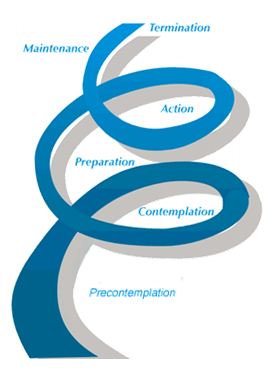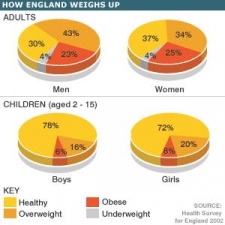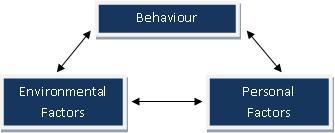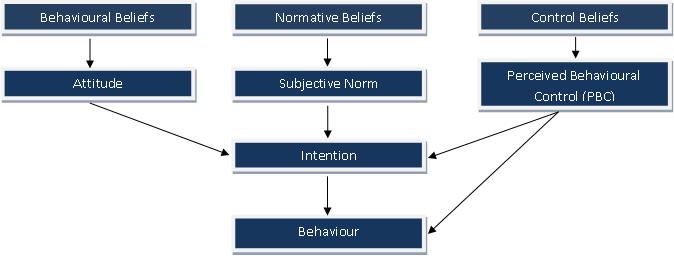Shaping Behaviour and Attitude in Childhood Obesity
Original Editors - Catriona Bartholomew, Brandon Koetsier, Gemma Donohoe, Jessica French and Patrick Holohan
Lead Editors - Your name will be added here if you are a lead editor on this page. Read more.
Introduction [edit | edit source]
Many of the life-long habits that jeopardize health are formed during childhood. Schools provide an excellent opportunity for preventing and treating obesity through changing these habits. Both physical activity and nutrition-focused interventions are already in place in many primary schools. In order to effectively implement these programmes it is important for teachers to understand what brings about the actual change in behaviour.
Designing interventions to produce or change certain behaviours; in this case health behaviours relating to childhood obesity; is best done with an understanding of behaviour change theories and an ability to apply them to practice.
This page will serve as an introduction to influencing attitudes and popular health behaviour models and provide suggestions as how these models may influence your teaching.
Learning Outcomes[edit | edit source]
By the end of this page the reader will be able to:
- Recognize the need to be aware of what brings about behaviour change.
- Describe theories that shape and influence behaviour and attitudes.
- To apply behavioural/attitudinal theories to effectively implement strategies to combat childhood obesity in (primary) school.
- To evaluate the effectiveness of your strategy to change the behaviours of the children.
Theories of Behaviour Change and Attitude [edit | edit source]
Changing Attitude:[edit | edit source]
Negative attitudes of obesity, reported among schoolteachers and children, can promote size discrimination toward large children and body dissatisfaction in children who view their body size as unacceptable. Appropriate education on how to self-monitor daily activity levels can help to empower individuals to maintain healthy long-lasting life-style habits.
To alter an individual’s behaviour it is thought that you must first instill a positive attitude towards the behavior. Weight loss should be looked at from the inside-out, rather than the normal outside-in perspective, meaning, our attitudes and beliefs must be appropriate before methods to change behavior are implemented. One way in which a pre-adolescent can be influenced in their attitudes is to help increase ones self-efficacy and educate them on effects of affirmations.
Shifting a child’s attitude is the first step in varying a child’s negative behaviour and beliefs towards weight. The following are key components that will influence personal attitudes:
Cognitive [feelings]: This component involves the student knowing about the subject that teachers are trying to influence the attitudes on.
Behavorial [thoughts/beliefs]: This component involves having the students engage in the behavior that you want them to display
Affective [action]: This component involves the urge to want to perform the desired behavior.
Affirmations:
[edit | edit source]
1. Keep information consistent and congruent so individuals can form a single attitude
2. Include messages that are high in affect and emotion (have a shock value)
3. Use messages that connect negative attitudes to past negative behaviours
It is vital to keep in mind that attitudes may not directly cause a behavior change but, it is necessary to help alter behavior.
Affirmations are statements that declare that something is true. The theory of self-affirmation is a psychological theory with the premise that people are motivated to protect an image of its self-integrity, morality and adequacy[1]. Self-affirmations are said to boost the self-concept and give you confidence to achieve goals[2][3].
The ‘Create Affirmations’ website has six easy steps to follow when writing self-affirmations:
1. Use the present tense
2. Use your voice, write them how you would speak them
3. Keep affirmations short and precise
4. Make them believable and realistic
5. Be literal
6. Use only positive statements[4].
Self-affirmation has been shown to be effective in terms of promoting a greater acceptance and changes in attitudes, intentions and behaviour[3].
In understanding how attitudes can be altered with the use of affirmations this strategy can be utilized in daily and weekly activities.
Ways to implement affirmations:[edit | edit source]
• Write affirmations as a class to be said out loud once a day. Affirmations can change each day of the week or every two weeks (if the affirmations are changed every two weeks repeat the same 3-4 affirmations daily). Note: Affirmations will be more effective if each pupil writes personal statements.
• A great site to use to help with writing affirmations is the WIKI How to page, found at : http://www.wikihow.com/Write-an-Effective-Affirmation
•Written affirmations can be used as an art project where children write personal self-statements and decorate them.
• Examples of affirmations: (http://www.vitalaffirmations.com/affirmations.htm#example%20affirmations)
Affirmations for Weight Loss
• I am the perfect weight for me
• I choose to make positive healthy choices for myself
• I will exercise regularly
Attention, Relevance, Confidence and Satisfaction (ARCS) Model of Motivational Design:[edit | edit source]
Motivation consists of the amount of effort a person is willing to exert in pursuit of a goal; hence, motivation has magnitude and direction [5].
Motivational design is concerned with:
- connecting instruction to the goals of learners
- providing stimulation and appropriate levels of challenge
- influencing how the learners will feel following successful goal accomplishment, or even following failure[6].
Ways to implement model:[edit | edit source]
Changing Behaviour:[edit | edit source]
Presented below are popular health models used to describe how people acquire certain behaviours. There is no 'correct' model, it is best to read through the models and think about which one best suits you and the situation you are trying to apply it to. In addition, suggestions on how the theories can be incorporated into the classroom sessions are provided below each model.
Social Cognitive Theory:[edit | edit source]
The Social Cognitive Theory (SCT) explains how people acquire and maintain certain behaviours [8] and has been extensively used in the field of health behaviour with respect to health promotion, prevention and modification[9].
Human behaviour is explained in terms of a three-way, dynamic, reciprocal model in which personal factors, environmental influences and behaviour constantly interact (Figure 1).
Figure 1: Triadic model from SCT.
An individual’s behaviour is uniquely determined by these interactions. Within this framework there are key constructs which determine behaviour patterns. The core determinants, in terms of health behaviour, are described in Table 2 ([10], [9], CommGAP (date)).
| Components |
|
|---|---|
| Knowledge |
of health risks and benefits |
| Reinforcements |
to establish the pattern of behaviour |
| Observational Learning |
Acquisition of behaviour through observation and experience |
| Self-regulation |
individual’s ability to manage or control behaviour |
| Outcome Expectations |
The outcomes people expect their actions to bring about. The perceived importance of these expectations may also drive behaviour. |
| Goal Setting |
establishing both individual and group SMART goals |
| Perceived Self-Efficacy |
An individual’s confidence in their own ability to perform behaviour. |
Self-efficacy is an important determinant of behaviour and is incorporated into many models of behaviour change. Self-efficacy makes a difference to how people think, feel and act [8]; [11]. According to the SCT a personal sense of control makes behavioural change possible (Predicting Health Behaviour Book – Conner and Norman). Bandura proposed that the actual performance of a particular behaviour is highly related to an individual’s perceived self-efficacy [12].
Low self-efficacy:
- lower expectations of successfully performing behaviour
- more effected by counterproductive situational temptations
High self-efficacy:
- Expects to succeed at performing behaviour
- More likely to succeed at performing behaviour
Unlike other models of health behaviour the Social Cognitive Theory offers both predictors and principles on how to inform, facilitate, guide and motivate people to adapt habits that promote health and reduce those that impair it ([11]).
How can this theory shape your teaching?
[edit | edit source]
To increase levels of self-efficacy:
- It may be important to provide resources and support to raise individual confidence.
- Behaviour change should possibly be approached as a series of small achievable steps (Perry 1990).
- Tasks should be moderately challenging so that students do well and make progress when providing reasonable effort.
Even a strong sense of self-efficacy may not lead to desired behaviour unless there is incentive (Bandura 1986)
- To facilitate behaviour change it may be important to provide incentives and rewards for the behaviours.
- Incentives may increase extrinsic motivation especially where intrinsic motivation is lacking.
Shaping the environment may encourage behaviour change.
- Provide opportunities for behavioural change
- Assist with changes
- Offer social support
- Recognize constraints that may deter behaviour change.
Outcome expectations:
- Students must believe if they complete learning tasks successfully, the outcomes they achieve are worthy of the effort necessary to reach them.
Goal setting:
- Goals that students set or endorse themselves have a bigger impact on their behaviour than goals that are assigned.
- Goals must be SMART (specific, measurable, attainable, realistic and time-targeted).
Theory of Planned Behaviour:[edit | edit source]
The Theory of Planned Behavior (TPB) is an extension of the theory of reasoned action (TRA). It states that the proximal determinant of behavior is the intention to act. The intention, in turn, is influenced by the attitude towards the behavior, the subjective norm, and the perceived behavioral control[13].
[14]
Subjective norm refers to the individual’s perceptions of general social pressure to perform (or not to perform) the behaviour. If an individual perceives that significant others endorse (or disapprove of) the behaviour, they are more (or less) likely to intend to perform it. Attitude towards the behaviour reflects the individual’s global positive or negative evaluations of performing a particular behaviour. In general, the more favourable the attitude towards the behaviour, the stronger should be the individual’s intention to perform it [15].
Perceived behavioral control is defined as an individual’s perceptions of their ability or feelings of self-efficacy to perform behavior. This relationship is typically dependent on the type of relationship and the nature of the situation.
Perceived behavioral control can also predict behaviour directly to the extent that the measure matches actual control.
How can this theory shape your teaching?[edit | edit source]
- Intention has been shown to be the most important variable in predicting behavior change. Intentions are assumed to capture the motivational factors that influence a behaviour and to indicate how hard people are willing to try or how much effort they would exert to perform the behaviour.
- This suggests that it may be important to present information to help shape positive attitudes towards the behavior and stress subjective norms or opinions that support the behavior.
- For perceived behavioral control to influence behavior change, much like with self-efficacy, a person must perceive that they have the ability to perform the behavior. Therefore, perceived control over opportunities, resources, and skills needed is an important part of the change process.
Transtheoretical (Stages of Change) Model:
[edit | edit source]
|
In the transtheoretical model, there are six stages that together form a progression for change:[16]Cite error: Invalid
These changes are described as "spiraling or cyclical", rather than a straight forward progression. This is due to the fact that individuals progress through the stages at different rates, and it is very common for individuals to move back and forth along the chain, before eventually reaching the desired goal of maintenance. [19] |

|
Moving forward through the stages are influenced by a set on independent variables known as "processes of change". These processes of change are a major contributing factor that allows us to understand how the shift in behaviour occurs. Numerous studies reveal that in order to have succesful behavioural change, these different processes should be used at particular stages of change[16].
Processes of Change: Experiential = early stage transitions Cite error: Invalid <ref> tag; name cannot be a simple integer. Use a descriptive title
1. Consciousness Raising (Increasing awareness)
ex. I remember some information that people gave me on how to not be obese
2. Dramatic Relief (Emotional arousal)
ex. I react emotionally to warnings about obesity and the dangers it can cause to my health
3. Environmental Reevaluation (Social reappraisal)
ex. I consider the view that obesity can be harmful to myself and others
4. Social Liberation (Environmental Opportunities)
ex. I see how society is changing in ways that make it easier to help with obesity
5. Self Reevaluation (self reappraisal)
ex. Seeing how obese I am makes me feel disappointed in myself.
Processes of Change: Behavioral = later stage transitions Cite error: Invalid <ref> tag; name cannot be a simple integer. Use a descriptive title
6. Stimulus Control (Re-engineering)
ex. I remove things from my home and lifestyle that may contribute to my obesity
7. Helping relationship (supporting)
ex. I have someone who listens when I need to talk about my obesity habits
8. Counter Conditioning (substituting)
ex. I find that doing other things instead of eating and sitting around are good for my obesity
9. Reinforcement Management (rewarding)
ex. I will give myself a reward when I lose some weight
10. Self Liberation (committing)
ex. I make commitments not to be obese anymore.
How can this theory shape your teaching?[edit | edit source]
- It is very important to match behavior change interventions to people's stages. (e.g. If the student is in the precontemplation stage, it is important to provide to them the information about the pro's and con's about losing weight).
- Without a planned intervention, people will remain stuck in the early stages due to lack of motivation to move through the stages
Bringing Theory to the Classroom:[edit | edit source]
Don't focus on negative aspects - positive attitude is more likely to facilitate behaviour change.
Useful links
[edit | edit source]
A useful visual guide on implementing ARCS Model:
http://www.torreytrust.com/images/ITH_Trust.pdf
Article on role of and applying SCT to the classroom:
http://www.education.com/reference/article/social-cognitive-theory/
Overview of attitude and behaviour change:
http://siteresources.worldbank.org/EXTGOVACC/Resources/BehaviorChangeweb.pdf
A more indepth focus on the Transtheoretical Model
http://www.uri.edu/research/cprc/transtheoretical.htm
Article on role of and applying Transtheoretical Model to the classroom:
http://www.ncbi.nlm.nih.gov/pubmed/18339335
References[edit | edit source]
- ↑ Wikipedia, The Free Encyclopedia. Self-affirmation. http://en.wikipedia.org/wiki/Self-affirmation (accessed 25 October 2012).
- ↑ Cohen, L.B. 2007. A manifesto for our times: affirmations to help develop a mindset to respond to the changing information culture. American Libraries, 38 (7) 08, pp.47-49.
- ↑ 3.0 3.1 Sparks, P., Jessop, D.C., Chapman, J. and Holmes, K. 2010. Pro-environmental actions, climate change, and defensiveness: do self-affirmations make a difference to people's motives and beliefs about making a difference? British Journal of Social Psychology, 49 (3) 09, pp.553-568.
- ↑ Creative Affirmations. Writing affirmations. http://www.creativeaffirmations.com/writing-affirmations.html (accessed 23 October 2012).
- ↑ Visser J, Keller JM. The clinical use of motivational messeges: an inquiry into the validity of the ARCS model of motivational design. Instructional Science 1990;19(6):467-500.
- ↑ Official site of John Keller’s ARCS Model. What is ARCS model? www.arcsmodel.com/ (accessed 12 Nov 2012).
- ↑ Learning Theories. ARCS Model of Motivational Design (Keller). http://www.learning-theories.com/kellers-arcs-model-of-motivational-design.html (accessed 12 Nov 2012).
- ↑ 8.0 8.1 Bandura, A. 1977. Self-efficacy: toward a unifying theory of behavioural change. Psychological Review, 84 pp. 191-215.
- ↑ 9.0 9.1 Redding, C.A., Rossi, J.S., Rossi, S.R., Velicer, W.F. and Prochaska, J.O. 2000. Health Behaviour Models. The International Electronic Journal of Health Education, 3 pp. 180-193.
- ↑ Bandura, A. 2004. Health Promotion by Cognitive Means. Health Education and Behaviour, 31 (2) pp. 143 – 164.
- ↑ 11.0 11.1 Bandura, A. 1997. Self-Efficacy: The Exercise of Control. New York, Freeman. Worth Publishers, 1st edition.
- ↑ Redding, C.A., Rossi, J.S., Rossi, S.R., Velicer, W.F. and Prochaska, J.O. 2000. Health Behaviour Models. The International Electronic Journal of Health Education, 3 pp. 180-193.
- ↑ Armitage, C.J. &amp;amp;amp;amp;amp;amp;amp;amp;amp; Conner, M. Efficacy of the theory of planned behaviour: A meta‐analytic review. British journal of social psychology 2001;40:4:471-499.
- ↑ Ajzen, I. The Theory of Planned Behavior. Organizational Behavior and Human Decision Processes 1991;50:179–211
- ↑ Hardeman, W., Johnston, M., Johnston, D., Bonetti, D., Wareham, N. &amp;amp;amp;amp;amp;amp;amp;amp; Kinmonth, A.L. Application of the theory of planned behaviour in behaviour change interventions: a systematic review. Psychology and health. 2001;17:2:123-158.
- ↑ 16.0 16.1 Velicer, W. F, Prochaska, J. O., Fava, J. L.,fckLRNorman, G. J., &amp;amp;amp;amp;amp;amp;amp;amp;amp;amp;amp;amp; Redding, C. A. (1998)fckLRSmoking cessation and stress management:fckLRApplications of the Transtheoretical ModelfckLRof behavior change. Homeostasis, 38, 216-233fckLRretrieved from: fckLRhttp://www.uri.edu/research/cprc/TTM/detailedoverview.htm
- ↑ Lach, H. Everard, K. Highstein, G. Brownson, C. 2004. Application of the Transtheoretical Model to Health Education for Older Adults. Health Promotion Practice. 5 (1) 88-93
- ↑ Bibeau, W., Moore, J., Caudill, P., Topp, Robert. 2008. Case Study of a Transtheoretical Case Management Approach to Addressing Childhood Obesity. Elsevier inc. 23 (2) 92-100
- ↑ Sharma, M. Romas, A. J. 2012. Theoretical foundations of health education and health promotion. Jones &amp;amp;amp;amp;amp;amp;amp;amp;amp; Bartlett Learning. Sudbury, MA.










